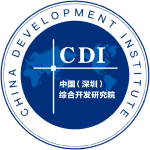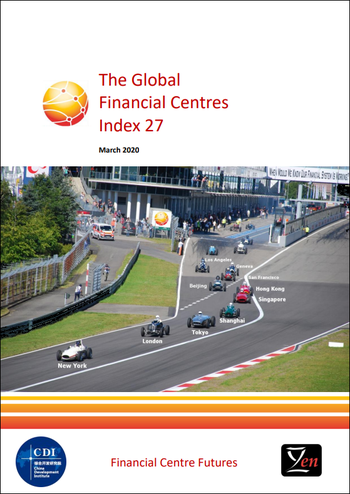Authors
Mike Wardle, Hugh Morris, Professor Michael Mainelli
Published by
Long Finance & Global Financial Centres (March 2020), 55 pages. Produced by Z/Yen in Partnership with CDI.
Share on social media:


The Global Financial Centres Index 27
The twenty-seventh edition of the Global Financial Centres Index (GFCI 27) was published on 26 March 2020. GFCI 27 provides evaluations of future competitiveness and rankings for 108 major financial centres around the world. The GFCI serves as a valuable reference for policy and investment decision-makers.
China Development Institute (CDI) in Shenzhen and Z/Yen Partners in London collaborate in producing the GFCI. The GFCI is updated and published every March and September, and receives considerable attention from the global financial community.
120 financial centres were researched for GFCI 27 of which 108 are now in the main index. The GFCI is compiled using 138 instrumental factors. These quantitative measures are provided by third parties including the World Bank, the Economist Intelligence Unit, the OECD and the United Nations.
The instrumental factors are combined with financial centre assessments provided by respondents to the GFCI online questionnaire. GFCI 27 uses 37,695 assessments from 5,064 respondents.
The Results Of GFCI 27 Include:
- GFCI 27 showed a high level of volatility, with 26 centres rising ten or more places in the rankings and 23 falling ten or more places. This may reflect the uncertainty around international trade and the impact of geopolitical and local unrest with a flight to stability; and also reflects the importance of sustainable finance, with Western European centres benefitting, and centres with a legacy of brown finance losing ground.
- Nine of the top ten centres in the index had lower ratings (eight of these centres fell by 12 points or more). Of the next 40 centres, 24 improved their rating while 16 fell.
- Eastern Europe & Central Asia showed the strongest regional improvement with twelve centres increasing their rating, while only two centres received lower ratings.
Leading Centres
- New York retains its first place in the index, further extending its lead over London from 17 to 27 points (although the ratings for both centres dropped by more than 20 points). Tokyo moved up three places to rank third in the index. Hong Kong fell from third place to sixth. Five Asian centres are now within ten points of London.
- Geneva, Los Angeles, and San Francisco entered the top 10, easing out Dubai, Shenzhen, and Sydney.
- Within the top 30 centres, Amsterdam, Edinburgh, Geneva, Hamburg, and Stockholm all rose by more than ten places.
Western Europe
- After a mixed performance in GFCI 26, this region had a strong performance in GFCI 27, with 23 centres rising in the rankings and five falling. Fourteen centres increased their ranking by ten places or more, including Geneva which is now in the top 10.
Asia/Pacific
- Asia/Pacific Centres had a somewhat downbeat performance with fifteen centres falling in the rankings and ten rising. This appears to reflect levels of confidence in the stability of Asian centres and in their approach to sustainable finance, which appears to be growing in its effect on the overall rating of centres.
- Tokyo and Shanghai improved their ranking in the top 10, whilst Singapore and Hong Kong fell.
North America
- North American centres showed little change from GFCI 26, with the exceptions of Calgary, which climbed 17 places, and Toronto which fell 12 places.
- Four out of the eleven North American centres are in the top 20.
Eastern Europe & Central Asia
- All bar two centres in this region improved their rating (the exceptions being Nur-Sultan and Istanbul). Nur-Sultan may rise rapidly as people become more familiar with the new name and residence of the Astana International Financial Centre.
- Nine of the centres improved their ranking (moving mainly from the bottom of the index to its middle), with four falling and one (Moscow) remaining in the same position.
Middle East & Africa
- Centres in the Middle East and Africa performed poorly with ten of the 13 centres falling in ranking. Only Nairobi and Riyadh improved their position. Tehran entered the index for the first time.
Latin America & The Caribbean
- Centres in Latin America & The Caribbean also performed poorly, with only the British Virgin Islands increasing its ranking (by 15 places). Barbados is a new entry.
Island Centres
- The British Crown Dependencies’ performances bounced back with the Isle of Man up 12 places in the rankings, Jersey up 10, and Guernsey rising 19 places.
FinTech
- For the second time, we include within the GFCI a separate index ranking financial centres as competitive places for FinTech.
- New York leads the FinTech rankings, followed by Beijing, Shanghai, London, and Singapore. Five of the top ten centres for FinTech are Chinese.
- Vilnius, on its first entry in the GFCI, ranks 13th in the FinTech ranking.




